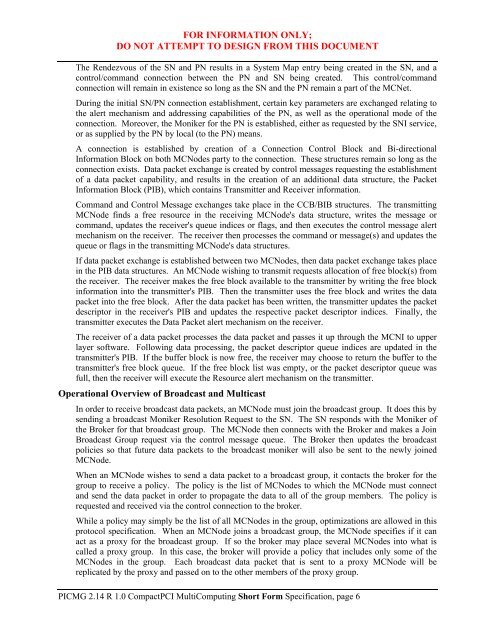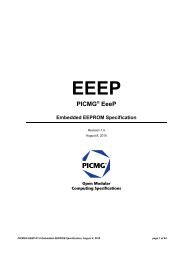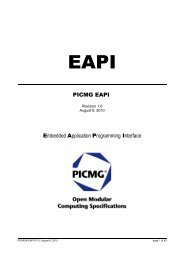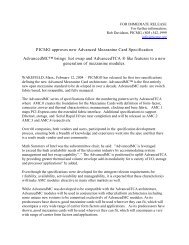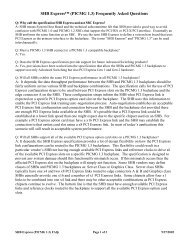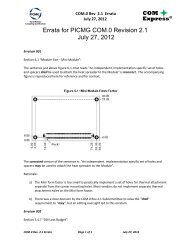PICMG 2.14, CompactPCI Multicomputing
PICMG 2.14, CompactPCI Multicomputing
PICMG 2.14, CompactPCI Multicomputing
Create successful ePaper yourself
Turn your PDF publications into a flip-book with our unique Google optimized e-Paper software.
FOR INFORMATION ONLY;<br />
DO NOT ATTEMPT TO DESIGN FROM THIS DOCUMENT<br />
The Rendezvous of the SN and PN results in a System Map entry being created in the SN, and a<br />
control/command connection between the PN and SN being created. This control/command<br />
connection will remain in existence so long as the SN and the PN remain a part of the MCNet.<br />
During the initial SN/PN connection establishment, certain key parameters are exchanged relating to<br />
the alert mechanism and addressing capabilities of the PN, as well as the operational mode of the<br />
connection. Moreover, the Moniker for the PN is established, either as requested by the SNI service,<br />
or as supplied by the PN by local (to the PN) means.<br />
A connection is established by creation of a Connection Control Block and Bi-directional<br />
Information Block on both MCNodes party to the connection. These structures remain so long as the<br />
connection exists. Data packet exchange is created by control messages requesting the establishment<br />
of a data packet capability, and results in the creation of an additional data structure, the Packet<br />
Information Block (PIB), which contains Transmitter and Receiver information.<br />
Command and Control Message exchanges take place in the CCB/BIB structures. The transmitting<br />
MCNode finds a free resource in the receiving MCNode's data structure, writes the message or<br />
command, updates the receiver's queue indices or flags, and then executes the control message alert<br />
mechanism on the receiver. The receiver then processes the command or message(s) and updates the<br />
queue or flags in the transmitting MCNode's data structures.<br />
If data packet exchange is established between two MCNodes, then data packet exchange takes place<br />
in the PIB data structures. An MCNode wishing to transmit requests allocation of free block(s) from<br />
the receiver. The receiver makes the free block available to the transmitter by writing the free block<br />
information into the transmitter's PIB. Then the transmitter uses the free block and writes the data<br />
packet into the free block. After the data packet has been written, the transmitter updates the packet<br />
descriptor in the receiver's PIB and updates the respective packet descriptor indices. Finally, the<br />
transmitter executes the Data Packet alert mechanism on the receiver.<br />
The receiver of a data packet processes the data packet and passes it up through the MCNI to upper<br />
layer software. Following data processing, the packet descriptor queue indices are updated in the<br />
transmitter's PIB. If the buffer block is now free, the receiver may choose to return the buffer to the<br />
transmitter's free block queue. If the free block list was empty, or the packet descriptor queue was<br />
full, then the receiver will execute the Resource alert mechanism on the transmitter.<br />
Operational Overview of Broadcast and Multicast<br />
In order to receive broadcast data packets, an MCNode must join the broadcast group. It does this by<br />
sending a broadcast Moniker Resolution Request to the SN. The SN responds with the Moniker of<br />
the Broker for that broadcast group. The MCNode then connects with the Broker and makes a Join<br />
Broadcast Group request via the control message queue. The Broker then updates the broadcast<br />
policies so that future data packets to the broadcast moniker will also be sent to the newly joined<br />
MCNode.<br />
When an MCNode wishes to send a data packet to a broadcast group, it contacts the broker for the<br />
group to receive a policy. The policy is the list of MCNodes to which the MCNode must connect<br />
and send the data packet in order to propagate the data to all of the group members. The policy is<br />
requested and received via the control connection to the broker.<br />
While a policy may simply be the list of all MCNodes in the group, optimizations are allowed in this<br />
protocol specification. When an MCNode joins a broadcast group, the MCNode specifies if it can<br />
act as a proxy for the broadcast group. If so the broker may place several MCNodes into what is<br />
called a proxy group. In this case, the broker will provide a policy that includes only some of the<br />
MCNodes in the group. Each broadcast data packet that is sent to a proxy MCNode will be<br />
replicated by the proxy and passed on to the other members of the proxy group.<br />
<strong>PICMG</strong> <strong>2.14</strong> R 1.0 <strong>CompactPCI</strong> MultiComputing Short Form Specification, page 6


